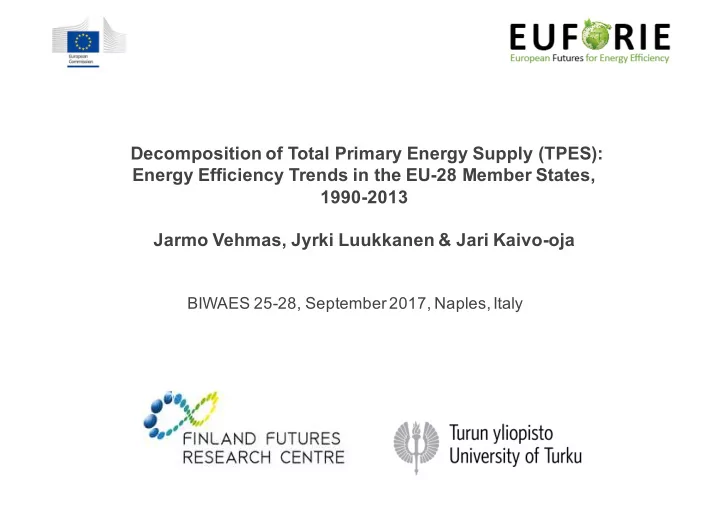

Decomposition of Total Primary Energy Supply (TPES): Energy Efficiency Trends in the EU-28 Member States, 1990-2013 Jarmo Vehmas, Jyrki Luukkanen & Jari Kaivo-oja BIWAES 25-28, September2017, Naples, Italy
Objective To find out how energy efficiency has affected total primary energy supply at the macro level in the EU-28 and the Member States
Energy efficiency - terminology Efficiency of a system = output per (unit of) input Energy efficiency of a system = output per (unit of) energy input Inverse of energy efficiency = energy input per (unit of) output = energy intensity Macro level (aggregated): TPES = TPES FEC Energy intensity = x GDP FEC GDP TPES = total primary energy supply FEC = final energy consumption GDP = gross domestic product
Methodology Chained two-factor decomposition analysis TPES FEC GDP Master equation: TPES POP = × × × FEC GDP POP During a selected time period. change in TPES is mathematically divided into effects of change in the drivers during the same time period: Change in TPES = TPES/FEC-effect + FEC/GDP-effect + GDP/POP-effect + POP-effect TPES = total primary energy supply FEC = final energy consumption GDP = gross domestic product (in constant prices) POP = amount ofr population
TPES/FEC TPES t =FEC t (TPES/FEC) t Δ (TPES/FEC) tt-1 Δ FEC tt-1 Δ (TPES/FEC) tt-1 TPES t-1 =FEC t-1 (TPES/FEC) t-1 FEC Δ FEC tt-1 TPES TPES FEC = × FEC
TPES TPES t-1 /FEC t-1 TPES/FEC eff , λ 1 =1 FEC eff , λ 1 =1 TPES t TPES t /FEC t FEC eff , λ 1 =0 TPES t-1 TPES/FEC eff , λ 1 =0 FEC FEC t-1 FEC t
Trend of FEC/GDP Mtoe/1000 USD 2005 0,20 0,18 0,16 0,14 0,12 0,10 0,08 0,06 0,04 0,02 0,00 1971 1981 1991 2001 2011 Cyprus Greece Italy Malta Portugal Spain EU-28
Trend of TPES/FEC 1,70 1,60 1,50 1,40 1,30 1,20 1,10 1,00 1971 1981 1991 2001 2011 Cyprus Greece Italy Portugal Spain EU-28
Example of results
Example of results EU28 and Italy, 1990-2000 10 8,1 6,5 6,4 8 % of 1990 TPES 6 4 1,8 1,2 0,8 2 0,2 0 -2 -0,5 -2,0 -4 -6 -8 -7,3 -10 TPES/FEC FEC/GDP GDP/POP POP TPES 1990-2000 Italy EU-28
Example of results
Example of results EU-28 and Italy, 2000-2005 3,6 4 2,9 2,5 3 % of 2000 TPES 2 1,1 1,0 0,9 0,8 1 0,2 0 -0,2 -1 -2 -2,1 -3 TPES/FEC FEC/GDP GDP/POP POP TPES 2000- 2005 Italy EU-28
Example of results
Example of results EU-28 and Italy, 2005-2010 2,0 1,3 1,1 0,8 1,0 % of 2005 TPES 0,0 -1,0 -0,5 -0,5 -2,0 -1,6 -1,7 -2,0 -3,0 -3,0 -3,3 -4,0 TPES/FEC FEC/GDP GDP/POP POP TPES 2005-2010 Italy EU-28
Example of results
Example of results EU-28 and Italy, 2010-2013 1,0 0,6 0,3 0,3 % of 2010 TPES 0,0 -0,1 -1,0 -0,8 -1,3 -2,0 -2,2 -3,0 -2,7 -3,2 -4,0 -3,7 TPES/FEC FEC/GDP GDP/POP POP TPES 2010-2013 Italy EU-28
Conclusions Chained two-factor decomposition analysis is an useful tool in identifying the effects of drivers contributing to change of TPES Decreasing energy intensity is an important driver of change in TPES. In many EU-28 Member States, TPES has started to decrease in the recent years Changing TPES/FEC ratio is not an important driver GDP/POP and POP usually increase TPES.
Recommend
More recommend